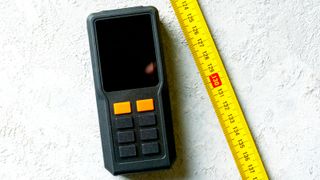Laser measure vs tape measure: Which should you use?
When it comes to laser measure vs tape measure, how do you decide which is best for you? Here we look at the pros and cons for both including accuracy and costs

Laser measure vs tape measure is a battle between the new and the traditional. Most DIYers, self builders and home renovators will already have a standard tape measure in their toolkit. It's an essential piece of equipment. So when it's time to upgrade should you look at a like for like replacement or embrace the new? Or, there’s another option, get both.
Knowinghow to read a tape measureis a simple enough skill to learn, and the same can be said for a laser measure. On a base level it's easy to learn, so what else does it have to offer? Here we take a look at the differences and costs between the two to help you make an informed choice.
Laser measure vs tape measure: What’s the difference?
The obvious difference between a laser measure and standard tape measure is how they measure distance.
A laser measure uses a laser to measure a distance. It sends out a beam that reflects off a selected surface and returns to the device. How long this action takes helps determine the distance. The result is displayed on a screen and unlike a manual tape measure a laser measure can perform calculations for you and store them for future reference. Much less of a need for pencil and paper. Find out more in ourWhat is a laser tape measureguide.
A standard tape measure is very much an organic tool, you need to pull out the tape and read the measurement from the tape. If your tape measure is too short for the distance being measured, you will need to measure a distance in stages. Beyond its core task of measuring there little else you can do with a standard tape measure.
Is a laser measure more accurate than a tape measure?
A laser measure is typically accurate to within one sixteenth inch (1.5mm) or one eighth of an inch (3mm) over long and short distances. But a clean line of sight is needed to reflect the beam while some surfaces can absorb a laser beam, which can compromise its accuracy.
Standard tape measures are divided into different levels of accuracy, and over shorter distances compare well with laser measures. Most tape measures fit into EC Class I or EC Class II with Class I being the most accurate. This has an 0.001% margin of error, or 1.1mm on a 10m tape. Class II is less accurate having a 0.002% margin of error, or 2.3mm on a 10m tape.
How do the costs between a laser measure and tape measure compare?
As a general rule a laser measure is typically more expensive than a standard metal measure, simply due to the technology involved in a laser measure. But a cheap laser measure can cost less than an expensive tape measure.
Digital laser tape measures – a hybrid of a laser measure and tape measure – are typically a little more expensive than a standard tape measure; there is crossover on prices dependent on brand, type, size and features.
Expect to pay anywhere from £5-£35 for a standard tape measure like theSTANLEY FatMax Next Generation Tape from B&Q. Unbranded basic three metre tapes sit at the low end of the price range, with prices gradually going up as the length increases - 5m, 8m, 10m – along with the build quality, additional features and brand name.
Basic laser measures like theBOLTHO Laser Measure 40M from Amazonstart at around £20-£25 with models with longer distances and/or more features costing around £80-£100.
Laser tape measures that combine the traditional tape measure and laser like theHuepar 2-in-1 Laser Tape Measure from Amazonstart at around the £40-£50 mark for a decent model.
What are the pros and cons of a laser measuring tool?
A laser is a good choice for measuring longer distances than a standard tape. A typical tape measure is available up to 10m (33ft) while laser measuring devices commonly do up to 50 metres. And you won't need an assistant to hold the other end of the tape.
They read longer distances much quicker and there is less chance of misreading a measurement as the result will be displayed on a screen, so all you need to do is read it. You can easily measure and read in low light conditions and you don’t need to climb up a ladder to get a floor to ceiling measurement.
The downsides are that they are typically more expensive than a standard tape measure, are not good at measuring short distances that don't have a surface to reflect off and in bright light you cannot see the beam so you are guessing where it is pointing. A laser measure also needs batteries – or recharging – to keep it operating.
Should a laser measure replace a tape measure?
This depends on what projects you are working on. A standard tape measure is a great general purpose measuring tool. It’s ideal for measuring distances whencutting skirting boards, placement of door furniture such as hinges and measuring wallpaper.
But if you are looking to measure longer distances like the length of a hallway or need the square or cubic meterage of a room a laser measure can achieve results much quicker than a standard tape measure
If you are a regular DIYer, self builder or home renovator we would recommend that you invest in both. You can do this by purchasing separately or getting your hands on a hybrid laser tape measure like the like thePREXISO Laser Rangefinder from Amazon.

Get the Homebuilding & Renovating Newsletter
Bring your dream home to life with expert advice, how-to guides and design inspiration, direct to your inbox.
Steve is Homebuilding & Renovating's DIY content editor, and has been a writer and editor for two decades. He is an avid DIYer with over 20 years of experience in transforming and renovating homes. He specialises in painting and decorating, but has strong all-round building skills, having previously worked in the industry for 10 years.
Bring your dream home to life with expert advice, how-to guides and design inspiration, direct to your inbox.
Thank you for signing up to Homebuilding. You will receive a verification email shortly.
There was a problem. Please refresh the page and try again.

